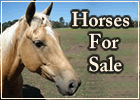

Speed Control on Trail
Hi Ed
I have a coming 6 year old gelding. He is a good boy and tries to please. When he sees a spotted horse (no matter mare or gelding) he gets upset. I don't know whether its fear or love, but he acts studdy around spotted horses. I haven't had him checked to see if he's proud cut. I guess I should, but even if he is, I can't control him when he acts like this. He is great any other time but when a spotty horse is around. He really is fun on the trail when we ride with a spotty horse because he collects all up and really is a racking machine but I can't hold him back and end up letting him do what he wants then just to keep the peace. He doesn’t buck or bite, just gets all bowed up and showy. Should I just put up with it or is there something I can do?Mary in upstate NY
Hi Mary,
I would definitely start with having him checked to see if he is proud cut or still producing testosterone. If so, this might explain his behavior and you can have this condition treated which could serve to calm him down considerably.
You don't have to "let him do what he wants just to keep the peace". The rider should always make all the decisions about two things - speed and direction. You want to be sure you have taught and practiced with him some very good basic control cues especially one rein lateral flexion and disengaging the hindquarter so that when he "acts studdy" or you feel you "can't hold him back" you can regain control quickly. When he becomes hard to handle you want to be able to direct that energy into constructive exercises that you and he know well and have practiced in calm training sessions. You should know how to ask him and he should know how to perform lots of different movements such as:
- flex the neck laterally left and right
- move the hindquarter left and right
- move the shoulder left and right
- back up
- shoulder-in
- side-pass
All these movements should be taught on the ground first then practiced in the saddle so when he becomes distracted by spotted horses you can refocus his attention on you by giving him lots of little jobs to do, moving different parts of his body in different directions. Change the jobs quickly to keep him really busy thinking about the job at hand and paying attention to your next request. You can't make him slow down or be calm but you can give him something to do with his energy. He will be able to release his nervous energy by moving his feet but in a constructive way that you are directing. For a full description of these essential exercises performed on the ground and mounted please see our instructional DVD, "Six Keys to Harmony" on our web site at http://www.eddabney.com/video.htm
When working with a high energy horse on the trail I also use dressage movements to control speed but frequently offer the horse the opportunity to simply walk along calmly. If the horse takes my offer and decides to walk nicely then we do, but if he speeds up again we go right back to practicing our dressage. This way we never have to fight, I just direct the energy into the feet through the positioning of the horse’s body.
If you are riding a horse that has more forward energy than you want, you may attempt to control the energy by fighting with the horse to try to hold him back but this accomplishes nothing more than making you frustrated and making the horse angry. Instead of fighting with the energy, direct it into something constructive by positioning the horse into a dressage movement like shoulder-in for example. In essence you’ll be telling your horse, “Thank you for all that extra energy, now use it to do a nice shoulder-in going down the trail.” Or “If you want to catch up with those horses in front of you so badly, you’ll have to catch up while doing half-pass!”
I was once riding a client’s very prancy, jiggy horse on a trail ride and rather than trying to fight against this undesirable movement I just used the horse’s natural pranciness to develop a fairly decent piaffe and passage on the trail.
Enjoy the Journey,

Ed Dabney is an internationally acclaimed clinician, presenting horsemanship and riding clinics all over the US and in Europe. In 2007, Ed was named Champion of the East Coast Trainer Challenge Series by Equine Extravaganza. Ed was honored to have been selected by the University of Georgia to teach their senior level Young Horse Training course.
His training articles have appeared in many major national magazines. Ed produces instructional videos and the “Gentle Horsemanship” TV program which has been seen on RFD-TV.
Ed's blending of natural horsemanship and classical equitation has made an indelible mark with students all across the United States and now also in Europe, drawing the attention of serious riders searching for the lightest touch and the deepest connection with their horses irrespective of breed or discipline.


